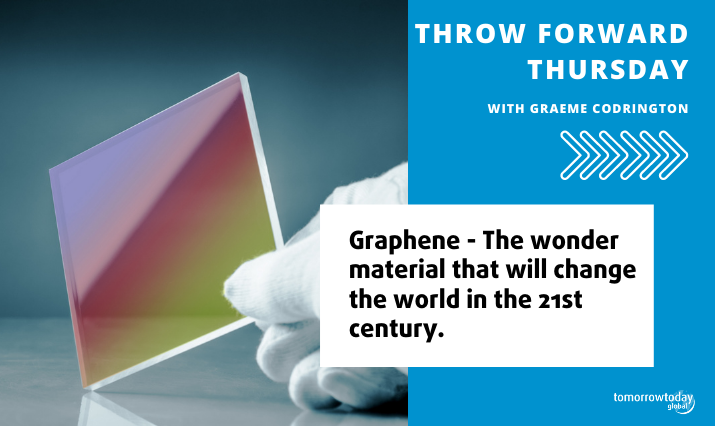TRANSCIPT
Welcome to the second edition of Throw Forward Thursday. Yes, my name is Graeme Codrington. I am a futurist. Doesn’t mean I can predict the future, but I look for disruptive change, for things that are going to change the world and specifically things that will change the world dramatically and forever. And every Thursday, I am going to talk about something that just blows my mind about the future. So today I want to talk about graphene. Graphene is a material that was discovered by two scientists at the University of Manchester in 2004 that won the Nobel Prize for it
It is a single layer of carbon molecules. So it’s a two dimensional material, basically, a single atom thick. It is 200 times stronger than steel. It can be made flexible if you want to, or rigid. The choice is yours. Depends how you make the material. It can be transparent, like glass or not. The choice is yours. It can conduct electricity better than copper. I think about ten times better than copper.
And it can conduct heat better than copper as well. Again, about four or five times better than copper. It can also take instructions like smart materials like silicon can, so it can be made a smart material and it’s lighter than air. I mean, it sounds like I’m making this up right. It sounds like I’m telling you about a space age material from some science fiction movie. This is what the Star Trek Enterprise is made of. But graphene is real.
And I think I need to talk about it in the same terms that we might have talked about concrete and steel a century or so ago, that it would change the landscapes of cities. It would change the way that we think about how we build things in the world because we can now build buildings out of graphene that would be lighter than the air inside them because graphene is lighter than air. It’s remarkable. And we could build electric vehicles that are unbelievably light.
So now we’re talking about flying cars and airplanes. And I think this might work for spaceships. And then well beyond the engineering stuff, when we go into batteries, using graphene as a basis for batteries seems to be something awesome. In fact, just go and have a look at graphene – up to date graphene news. There’s a lot of websites dedicated to it. Now you’ll see everything from new computing applications to using filters in medical devices. I mean, literally, the list goes on and on and on.
This wonder material graphene, if you have heard of it. Excellent. Keep an eye on it, if you haven’t heard of it before. Why not? If it’s such an amazing material, you know, it’s nearly 20 years old, why haven’t you heard of it? Because it’s quite expensive to make and the mechanisms that we’ve got to make it at the moment, it’s not really accessible yet. But, the cost of graphene is plummeting every every year.
It’s kind of halving at the moment. And very soon we’ll find a way to manufacture it in a way that makes it accessible and usable in all the types of things I’ve just talked about.
A wonder material as remarkable as steel and concrete were as remarkable as electricity was remarkable as the wheel was. In changing how our world looks, I can’t even imagine some of what graphene will do for us. But I know I’m keeping my eye on it and so should you. If you’d like more information about some of the things we should be watching, we’ll make sure you subscribe to my YouTube channel, click the bell so that you get notifications when new videos are put up.
And every Thursday we’ll go together to the future.
Graeme Codrington, is an internationally recognized futurist, specializing in the future of work. He helps organizations understand the forces that will shape our lives in the next ten years, and how we can respond in order to confidently stay ahead of change. Chat to us about booking Graeme to help you Re-Imagine and upgrade your thinking to identify the emerging opportunities in your industry.
For the past two decades, Graeme has worked with some of the world’s most recognized brands, travelling to over 80 countries in total, and speaking to around 100,000 people every year. He is the author of 5 best-selling books, and on faculty at 5 top global business schools.


